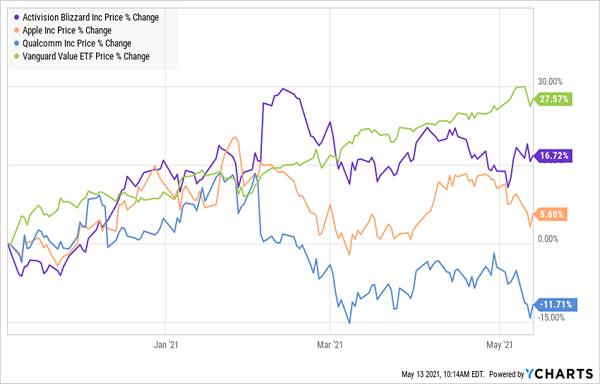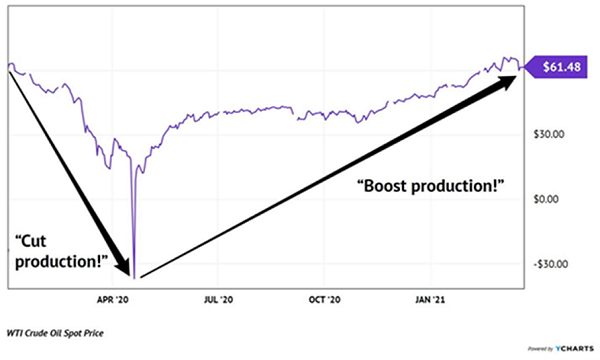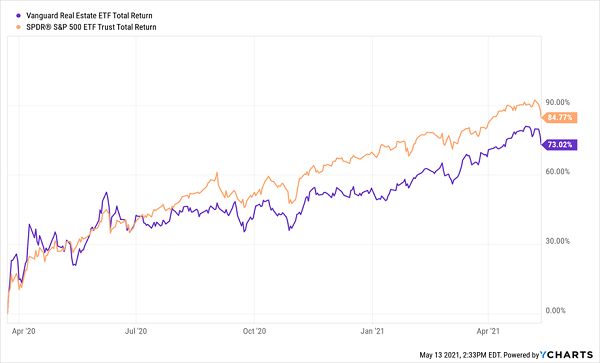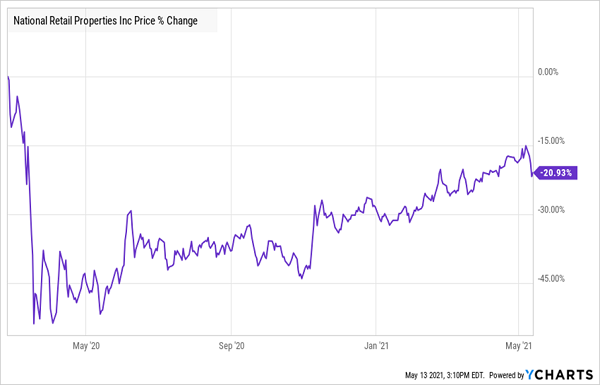Don’t let this inflation panic rattle you. This market is really just shifting gears, and we’re going to shift along with it, riding the waves to some big dividends that are about to switch into growth mode.
But timing is critical here, because we’re not going to be sitting on these dividends forever. Consider them a “swing trade” to bag big payouts now, plus some hefty dividend hikes. Then you’d take your returns on to the next bargain high yielder when the time is right.
More on this week’s hot-potato dividend plan in a sec. First, let’s delve into what this inflation-panicked market is up to, and how we contrarians can catch a tailwind.
Go-Go Growth Is … Go-Go Gone?
Since the March 2020 crash, the crowd was focused on growth stocks, with stay-at-home beneficiaries in the tech sector, like Apple (AAPL), Activision Blizzard (ATVI) and chipmaker Qualcomm (QCOM), posting big gains.
Tech Ruled 2020 …

But then something funny happened: despite all the bleating about tech in the media lately, these stocks really started to stall out months ago—back in the fall. Then, quietly, unsexy big-cap value stocks took the reins.
Check out how the Vanguard Value ETF (VTV)—in green below and packed with boring blue chips like JPMorgan Chase & Co. (JPM), insurer UnitedHealthGroup (UNH) and oil major Exxon Mobil (XOM)—tore past the three tech titans above:
… But 2021 Is All About Value

The good news is that an uptick in inflation is good for these stocks (particularly value names like the ones VTV holds).
Value Stocks Are Just Getting Going
Why is that? For one, a rise in inflation and interest rates indicates an economy en fuego, pointing to strong gains for the corners of the market associated with value, like banks (which make up the biggest slice of VTV’s portfolio).
Finance stocks profit from the gap between the Federal Reserve’s overnight-lending rate (near zero) and the yield on the 10-year Treasury note (around 1.7%, nearly double what it was in December), pacesetter for rates on everything from car loans to mortgages.
And as I wrote last Wednesday, I see this rate heading to 2% in the coming months, which will pad bank profits, and dividends, further, before the 10-year’s yield likely gets stuck. (I laid out a list of banks and insurers for you to target in my May 11 Contrarian Outlook article.)
Stuck? How can that be, with Jay Powell’s printing press in overdrive?
Even though the U.S. supply may be spiking, the “velocity” of this money has plummeted to post-World War II lows. This is a measure of how fast money changes hands.
Everyone thinks one dollar is one dollar. But once it gets moving, it can pack more punch than “just a buck” and become inflationary. People feel confident and spend more on their next trip (the vacation they’ve been waiting a year for.) The Airbnb host collects the cash and spends it elsewhere. Round and round the dollar goes as it multiplies and creates price pressures.
This type of high money velocity is generally a prerequisite for inflation. But velocity has been in a downtrend for the past two decades!
Money Moves Slower These Days

In early 2020, before the word “lockdown” was a colloquial term, the 10-year Treasury paid nearly 2%. We’ll soon have the same type of economy. So, it would be natural for the 10-year yield to head back to 2% and probably get stuck.
Let’s think back to 2009, which may be a more apt financial analogy than the 1970s. In ’09, we had a fragile economy recovering, a boatload of new Fed money and worries about inflation.
The inflation never really stuck in terms of consumer prices. But the stock market sure soared. As I write to you the S&P 500 has rallied more than 500% from its March 2009 lows. And that is a great sign for our value stocks today!
Oil and Gas Stocks Fire Up
Another canny value play right now is energy stocks, which are in the middle of a predictable “crash ’n’ rally” pattern that last unfolded from 2008 to 2012:
Here’s how it typically plays out:
- First, demand for oil evaporates due to a recession. Oil prices crash.
- Next, energy producers slash costs and production.
- The economy recovers. Energy demand picks up.
- But there’s not enough supply! So oil prices climb.
- Energy producers bring supply back online, but it takes time to explore and drill. Supply lags demand for years, and the price of oil climbs and climbs.
We’re still early in this latest crash ’n’ rally pattern. We should assume that oil prices will keep climbing for the next two or three years at least.
Oil’s Crash ’n’ Rally: 2020 to Present (and Counting)

My bet? Oil will clear $100 again before this rally is done.
Beneficiaries here are companies like Exxon, which yields 5.8% today, and oil-sands play Canadian Natural Resources (CNQ), which yields 4.9%. Both stocks also trade at reasonable forward P/E ratios (of 17 and 9, respectively), showing they have room to run despite the strong gains they’ve posted this year.
About Those “Short Hop” Dividend Trades …
Which brings me back to those “swing trades” I mentioned earlier. They’re real estate investment trusts (REITs), property landlords with dividends that far outpace those of regular stocks—as I write this, the typical REIT yields 3.3%, nearly double the payout on regular stocks.
And while REITs have soared coming out of the March 2020 crash, they still lag the S&P 500, a clear sign they have more upside:
REITs Revive, But There’s Still Room to Grow

We’re going to target a corner of the REIT market that gets a lot of heat from investors—including me: mall REITs.
I know what you’re thinking: “Brett, haven’t you been going on and on about how malls are yesterday’s news—victims of Amazon?”
That’s true—and my view hasn’t changed. It’s why we’re talking about riding these REITs to short-term gains (and dividends) over the next six to 12 months as the reopening hits its stride.
Consider National Retail Properties (NNN), which yields 4.5% and rents out standalone buildings to tenants who take on the taxes, maintenance and insurance costs themselves. It’s a savvy model that frees up NNN from cost and risk.
That, plus the wide range of retailers it rents to, helped it bounce back from the pandemic: NNN collected 97% of the rent due in the first quarter and 98% due as of the end of April. It also boasted a 98.6% occupancy rate.
What’s more, funds from operations (FFO, the main REIT cash flow metric) were up in the first quarter, and the dividend accounted for just 68% of adjusted FFO in that timeframe. That’s well down from the 81% paid out in the last 12 months, suggesting a restart in payout hikes could be at hand.
Finally, NNN still trades well below its pre-COVID peak, even though its occupancy and rent-collection rates are nearly back to where they were then. The stock is closing the gap, though, indicating the potential “swing trade” upside here.
NNN Heads Back to “Normal”

Again, I’m not saying mall REITs should be held for the long haul—NNN and its ilk will still struggle with rising e-commerce and the need for social distancing many people will continue to feel post-pandemic.
But if you’re looking for bargain-priced reopening investment for the next few months, this could be it: while riding select retail REITs back to pre-COVID levels, you’d bag a high and potentially growing payout, then shift your profits into a longer-term income play.
2X Your Money Every 5 Years—or Less—With These “American Reset” Stocks
And what are those long-term income plays?
I’ve got you covered there, too, with my top 7 “American Reset” stocks to buy right now. These 7 rock-solid dividend growers are primed to return 15% a year—year in and year out—by riding the surging trends that the pandemic has set in motion across the American economy.
These trends are anything but short term. They’re here to stay—and they’re just getting going. And with 15% annual returns rolling into your portfolio, you could double your money every five years. And thanks to these stocks’ soaring dividends, you could see your income triple, too.
They’re ripe for buying now. Full details are waiting for you—names, tickers, best buy prices and my complete breakdown of the surging trends powering these 7 dividend machines—right here.
